 Editor’s note: Celebrate the 10th anniversary of IgnatianSpirituality.com with us. For 10 weeks, we’ll be “Counting the Gifts of Ignatian Spirituality” by bringing you special content on our website and special offers from our sponsor, Loyola Press. Learn more here.
Editor’s note: Celebrate the 10th anniversary of IgnatianSpirituality.com with us. For 10 weeks, we’ll be “Counting the Gifts of Ignatian Spirituality” by bringing you special content on our website and special offers from our sponsor, Loyola Press. Learn more here.
Once called “Devil’s Valley,” California’s Desolation Wilderness is a 100-square-mile protected “forest” near one of the most beautiful spots on earth (in my opinion): Lake Tahoe. I see this topography within my home state as a metaphor for my spiritual life, where I can often be on the crest of beautiful union with God and soon be in a crevice of despair. It isn’t always a great distance from consolation to desolation.
The Desolation Wilderness features barren rocky expanses, massive granite formations, and a sparse landscape where trees are patchy and rare at higher elevations. It’s also an ideal habitat for rodents. I’d rather hike elsewhere, and the same is true of my spending time in desolation. When it comes, I want out!
Hiking this wilderness can feel long and arduous. It takes patience, persistence, determination, and grit—the same things I need when I encounter spiritual desolation.
When we go hiking in a wilderness of spiritual desolation, eight tools for combatting the desolation should be put in our backpacks. But be sure not to pack the pity party. It’s what the enemy wants: complaining about those blisters and bunions.
-
- Resolve. When in desolation, never make a change! This is #1 on the list. Desolation is not clinical depression, although symptoms and words to describe both seem similar. Desolation is that which yanks us from faith, hope, and love, leading us to see only weeds, taste trail dust, desire to walk in isolation, and feel worn out, unmotivated, or just plain lousy.
- Extra prayer. We don’t feel like praying more when spiritually desolate. But sweating it out during dull prayer is a great walking stick to lean on in rough terrain.
- A map. There will be a way out, with God’s help. Looking back over the route may also tell us how we got here.
- A flashlight and a friend. See a spiritual director, visit a neighbor, call a friend, or talk to a family member about what’s going on, rather than giving in to the temptation to isolate. When we shine a light on some of our secret thoughts and feelings, they lose some of their power. Evil loves secrets.
- A journal. We write about our experiences when we get out of the wilderness. It keeps us humble to see how quickly we can get lost when we think we’re in control. Pray with the lived-through experiences in mind.
- Water. Share our canteens. Just like consolations when we get them: they are meant for the community, not just ourselves. When we’re near a stream, refill. Consider how we will act when the water, and consolations, run short. Store up strength when we can, just as a squirrel stores up supplies for winter.
- God’s grace. We may need to remind ourselves that God’s grace is sufficient—and always available. We might think that we just drew the last ounce of patience out of that backpack, but when we reach back in, that grace is replenished. Amazing!
- Gratitude. Thank God that the desolation won’t last. Let’s praise God while we keep moving. A great view of Lake Tahoe is just over that next peak.


Thank you Loretta…
These are practical and user-friendly tips to overcome desolation wilderness. I relate to most of them. Keep on inspiring those who need this motivation most.
Thank you Loretta these are great tips to help us move foward.
Thank you for sharing some water from your canteen.
Right on and so beautifully written! I’m going to print it out and share it with friends and directees.
Very well done, Loretta! Keep up the good work.
Thanks for sharing this wisdom.
Loretta, thank you, this is timely. I need to hear it now. Thankfully, I am already using some of these but the reinforcement that I’m on the right track is helpful.
This is great, Loretta! Love the imagery and handy list! Thank you.
Useful tips. Thanks. Well written and meaningful.
Wonderful and practical advice. I found this very helpful and the comparison to hiking in the Desolation Wilderness will help me remember the various suggestions. Excellent column. Thank you.